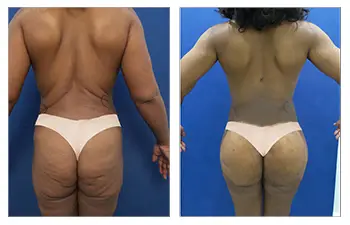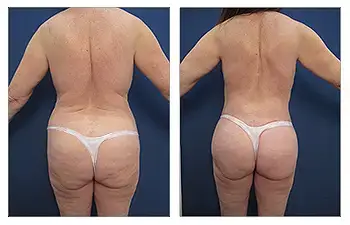What is Thigh Reduction and Tightening?
Thigh reduction and tightening refers to cosmetic procedures that aim to slim, reshape, and smooth the appearance of the thighs. Common techniques range from liposuction to remove fat, minimally invasive procedures such as Renuvion skin tightening to counter loose skin, and a thighplasty to eliminate redundant skin in the thigh region. In summary, minimally invasive and invasive methods may be employed to create better-proportioned, slimmer, and toner-looking thighs.

Options for Thigh Reduction and Tightening?
Options for thigh reduction and tightening are several and include considerations for fat removal and skin tightening. Whereas fat removal involves liposuction, regardless of the technique chosen, skin tightening has multiple options that include various minimally invasive measures or more aggressive invasive skin excision tactics.
Renuvion Skin tightening
Renuvion resurfacing uses radiofrequency energy to heat tissue below the skin’s surface which causes collagen fibers to contract and stimulates new collagen. This leads to firmer, tighter, and smoother skin on the thighs with mild downtime. This treatment is considered minimally invasive as it utilizes slee wands to deliver the thermal energy from under the skin following the completion of liposuction.
BodyTite
BodyTite is another minimally invasive procedure that combines liposuction fat removal with radiofrequency skin tightening for optimal modest thigh contouring results. Small incisions are made to insert the thin BodyTite probe which delivers heat below the skin to melt fat and stimulate tightening while suction removes the fat. Mild bruising, swelling, and numbness may occur and results are subtle.
Thighplasty
A thighplasty, also called a thigh lift, removes excess, sagging skin from the thighs along with fat removal resulting in a trimmer, tighter, and more youthful thigh contour. An incision is made inner or outer thigh to lift and tighten skin and tissues. Scarring occurs but is usually well hidden by clothing and swimsuits. Significant swelling, bruising, and wound care are needed initially.
What is a Thigh Lift (Thighplasty)?
Thigh lifts are excisional surgeries designed specifically to eliminate skin redundancy that may be observed throughout the skin. The areas of skin redundancy on the thighs have been localized to the inner thigh and the outer thigh. The inner thigh skin redundancy may present along the entire height of the leg or be isolated to the upper inner thigh. The outer thigh skin redundancy is typically localized to the outer hip region.
Differences in the lateral thigh and medial thigh skin quality must be taken into account. In general, the lateral skin has increased elasticity and will snap following fat removal with VASER liposuction. However, the medial thigh skin routinely loses its elasticity early in life as depicted by its crepe-looking appearance, especially over the upper inner thigh region. Furthermore, differences in contour nuances should be recognized between the medial and lateral thighs.
The lateral thigh fat should be conservatively removed as there needs to be a smooth transition between the more generous mid-buttocks and the upper lateral leg. In contrast, the medial thigh fat can be more aggressively removed to create an aesthetically pleasing thigh gap; however, aggressive fat removal must be balanced with managing increased skin redundancy and poor skin texture, as discussed above.
Medial thigh lift
A medial thigh lift tightens loose skin along the inner thigh with an incision running from the groin crease down the inner leg possibly to the inner knee or be limited to the groin region only. These surgeries allow for the elimination of the inner thigh skin.
Vertical Thigh lift
This procedure removes loose, hanging skin from the front, sides, and/or back of thighs with a vertically oriented incision starting below the buttock fold and extending down the thigh. Although the inner thigh vertical excess skin excision allows for dramatic reduction of thighs, it does leave a long incision line and potential for a long scar. Scars can be hidden by placement in the natural shadow created by the adductor longus and magnus muscles or by limiting the length of the incision to above the short line.
Groin-based thigh lift
This lift specifically targets loose skin in the groin and upper inner thigh region. A curved incision is made high in the groin crease allowing the surgeon to tighten only the upper deeper tissue layers while removing excess skin. Scarring is minimal but the lift only affects the upper thigh.
Outer thigh lift (Lateral thigh lift)
An outer thigh lift uses an incision high on the outside of the thigh starting near the hip area then curving downward lifting and removing loose, overhanging skin from the outer and posterior (back) thigh. This reduces saddlebags and leads to a more toned outer thigh appearance but leaves visible scarring. It is usually combined with a buttock tuck to allow for the correction of a sagging buttock cheek skin and posterior thigh cellulite.
Improvement of Vertical Thigh Appearance with High Definition Thigh Lift
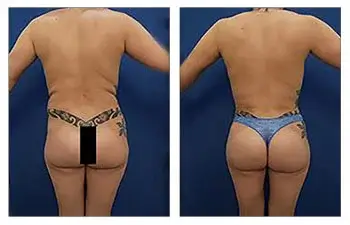
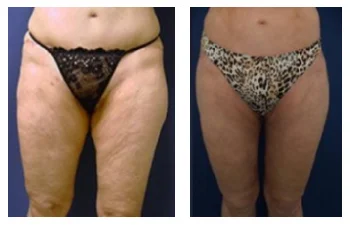
Recovery after a thigh lift
Recovery after a thigh lift involves significant downtime, often 2-3 weeks or longer. Patients need assistance standing, walking, and caring for themselves early on as swelling and discomfort make movement difficult. Bruising, swelling, numbness, and wound care are common during the weeks following surgery. Compression garments must be worn to minimize swelling and promote healing. Most return to non-strenuous daily activities after 2-4 weeks but strenuous exercise should wait several more weeks. Complete results show over the next 3-12 months.
Thigh Lift Risks
Possible thigh lift risks include bleeding, infection, scarring issues, contour irregularities, skin loss, blood clots, fluid build-up, nerve damage, and loss of thigh muscle strength. Poor wound healing and widened, thick, red scars can also occur in some patients along incision sites on the thighs. Revision surgery may be done later to help correct significant complications if they arise or to refine results.
What Results Can Expect After My Thigh Lift?
Thigh lift results provide a more toned, smoother, and firmer thigh contour for most patients. The procedure trims excess skin, reduces cellulite dimples, minimizes Rubbing between the thighs, and lifts the butt. However, visible scarring on the inner or outer thighs occurs. Maintaining a stable weight is key for preserving a tighter, more shapely thigh appearance in the long term.
Cost of Thigh Lift Surgery
The average cost for a thigh lift is $7,500 - $10,000 which does not include fees like facility, anesthesia, or prescriptions. The extent of correction needed, type of thigh lift done, surgeon fees, hospital vs surgical center, and geographical location all impact overall costs which can range higher. Insurance does not cover thigh lifts performed solely for cosmetic reasons.
Thigh reduction and tightening with High Definition liposuction
Thigh reduction surgery using high-definition lipo protocols results in optimal appearance and avoidance of scars.
Improving the appearance of the thighs requires consideration of multiple factors. First, we must identify the scope of the concern areas that may include the inner or medial thigh versus the outer thigh, the upper thigh versus the entire thigh, and finally, any differences between bilateral thighs. Appropriate assessments of the thigh's appearance must consider not only the fat excess but also the degree of skin redundancy.
Fat excess is best removed using VASER liposuction. In contrast, the treatment of skin is dictated by two factors; The first consideration is the severity of skin excess. The second factor requires understanding whether skin excess lies in the horizontal axis, termed skin redundancy or in the vertical axis, termed skin laxity.
When skin redundancy is minimal, high-definition protocols using a combination of VASER liposuction and Reunvion subdermal skin tightening will avoid the need for invasive excisional surgeries. However, if skin redundancy is moderate to severe such as the traditional vertical thigh lift surgery is necessary. Skin elasticity alone can be accommodated using minimally invasive high-definition contouring protocols.
When there is minimal skin elasticity, VASER liposuction alone will suffice since skin retraction will occur following the comprehensive removal of fat. With moderate skin redundancy, Renuvion® subdermal coagulation technology can be harnessed to tighten the skin. This modality utilized helium-activated radiofrequency energy that literally heats the underlying deep skin surface,, called the dermis, and infrastructural cables that span the soft tissues resulting in a shrink-wrap effect. Only if severe skin redundancy is present, then a tucking procedure such as a medial thigh tuck or lateral thigh tuck must be performed synchronously to remove all skin redundancy.
Thigh reduction surgery requires an intimate balance of excess fat and redundant skin. When contoured appropriately, dramatic improvements can be appreciated in the lower buttocks and thigh region.
Mini Thigh Lift without scars
Today's thigh reduction and tightening services require out-of-the-box plastic surgery considerations. The traditional thigh lift procedure defined by excisional thigh lift surgery is not tolerated by the cosmetic surgery community. Instead, most clients stress minimally invasive surgeries and safety as their top two priorities. In summary, High Definition Body Contouring protocols as described above are a frequent request for thigh reduction and tightening.
High Definition Thigh Lift
This liposuction and Renuvion J plasma skin tightening remain the mainstay of high-definition thigh reduction and tightening. Treatment of bilateral thighs and knees is feasible without the placement of any incisions. Moreover, the specialized protocols proposed allow for treatment of the entire thigh; this includes reducing both vertical thigh and horizontal thigh skin redundancy while liposuction of both the inner and outer thigh provides the elimination of excess fat.
Most notable improvements are observed along the upper thigh wherein skin redundancy is most frequently observed. A mini thigh lift effect can be achieved without any incisions! In contrast to a breast lift that requires incision lines, traditional thigh lift surgery of the thighs has fallen out of favor due to the above novel surgeries.
An excisional surgery requires incisions to be made during surgery which are not ideal. In fact, when considering excisional surgery, it is always a balance between improving your contour versus getting an incision line. Today, we have an alternative, minimally invasive option to treat the thighs.
How does Buttock Tuck affect appearance of Thighs
Consideration of your buttock appearance is essential when addressing the appearance of your thighs. Specifically, the lateral thighs and posterior thighs are affected by a buttock cheek that sags down and compresses against the upper thighs. This effect is most dramatic following weight loss which results in buttock cheek deflation and resulting sagging and leaning on the upper thighs. Correction of the buttock sagging in weight loss patients is unique and requires a modified Brazilian Buttock Lift that includes a buttock tuck in addition to fat transfer. Our surgeons have designed a unique protocol to perform the buttock tuck that maximizes the aesthetic improvement in both the buttock cheeks as well as the thighs which is detailed in The Aesthetic Plastic Surgery journal.
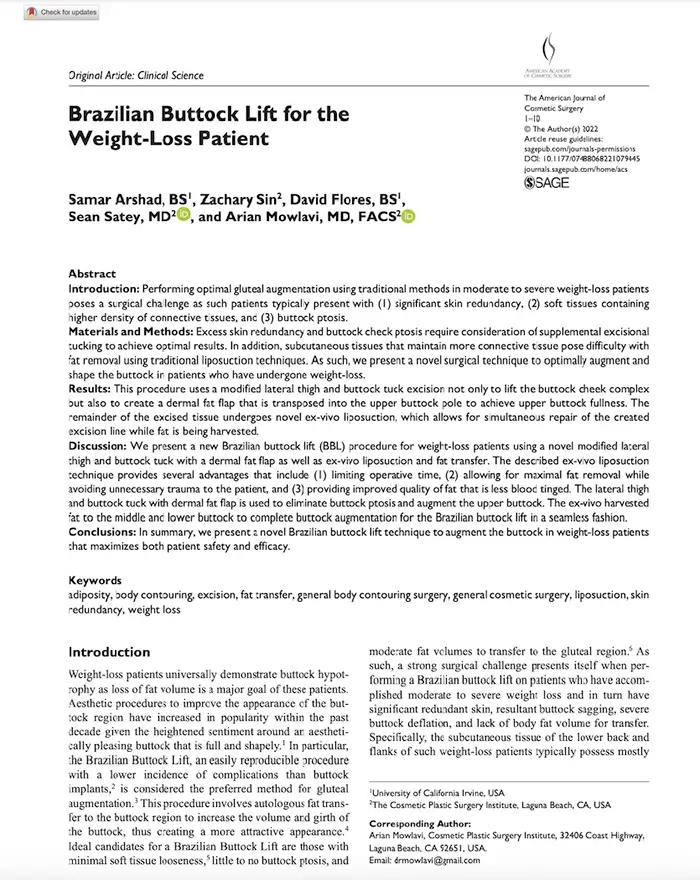
Conclusion: Thigh reduction and tightening
When you commit to getting a plastic surgery procedure such as a thigh lift, it is important to consider all of your alternatives. Lifting the thighs with a thigh lift is not simple. You must consider both the inner and outer thigh excess as well as the vertical extension of the skin and fat. Thigh lifts are performed in plastic surgery using a traditional excision that extends along the inner thigh.
However, this plastic surgery procedure is not without consequences of a long incision line along your inner thigh. It is necessary to discuss the precautions of a long scar with your plastic surgeon to determine whether the minimally invasive alternative described may be viable.
Thigh Reduction and tightening Photo Gallery
